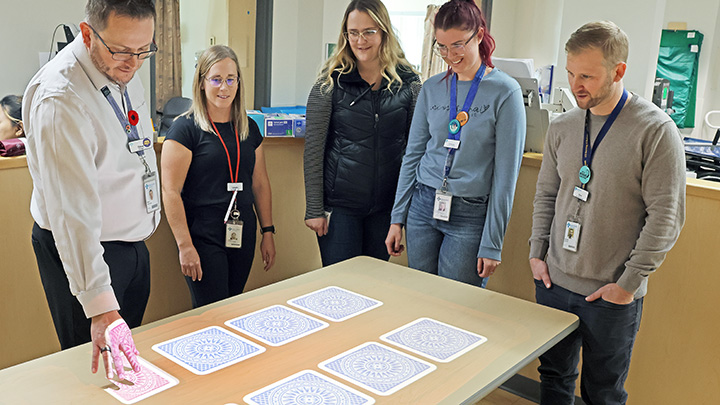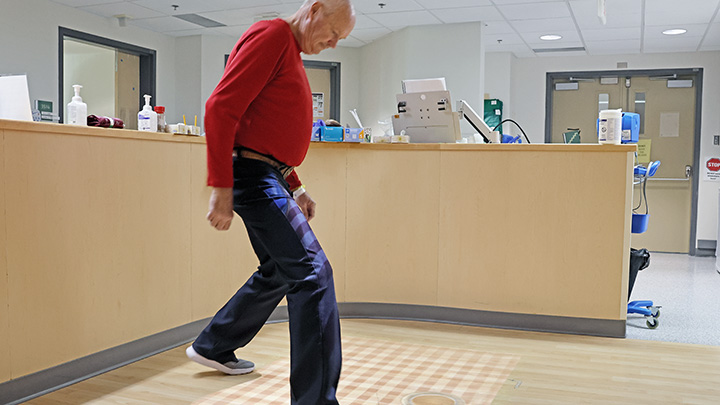
December 9, 2024

Colleagues from Units 33 and 35 at Red Deer Regional Hospital Centre gather round as Steve Tetz tries his hand at Leisure Memo, a virtual card game that challenges the part of the brain that controls executive functions, including planning and decision-making. Pictured, from left, are: Tetz, Letasha Reid. Kaylin Berlinguette, Candice Morse and Michael Dew. Photo by Jonathan Koch.

Grant Gordon stomps on virtual moles projected onto the floor while working to regain his mobility using the new Tovertafel unit at Red Deer Regional Hospital Centre. Photo by Jonathan Koch.
Story & photos by Jonathan Koch
RED DEER — Grant Gordon was in rough shape when he arrived at Red Deer Regional Hospital Centre.
Admitted to the hospital’s Rehabilitation Unit 35 after suffering a brain injury, Gordon says he initially dreaded the weeks of rehab to come.
“I didn't want to talk to anybody. I didn't want to see anyone. I thought it was going to be hell,” says Gordon.
A month later, the Innisfail-area resident has returned home, his injury improved, and perspective transformed due in part to a magic table called Tovertafel.
Developed in the Netherlands, the Tovertafel (English for “magic table”) system combines a projector, infrared sensors, and specialized software that transform floors and tables into an interactive play area.
Gordon used the system throughout his stay in Unit 35 to help regain his mobility. Playing interactive games that respond to the movement of his hands and legs, he was able to improve his vision and cognition while practising his balance in a unique and fun way.
“You get a few people watching and kind of laughing or cheering or jeering and it makes it even more fun,” adds Gordon.
According to Mike Dew, acute care manager of the Neurology and Medicine Unit 33, the Tovertafel was introduced to improve the rehabilitation journey of stroke and neurological patients. Dew hopes the installation of the magic table in neighbouring Unit 35 is the first step in creating a shared integrated neurology service between the two departments.
“The gold standard in Canada for stroke specific care is an integrated stroke unit where you have acute care and intensive rehab in the same place,” says Dew. “The Tovertafel is our first step to being able to work even more tightly with each other and really make sure that the doors between Units 33 and 35 are open as much as they can be.”
As both departments continue exploring opportunities to integrate their stroke services, Unit 35 manager Steve Tetz says his staff are becoming more aware of what goes on in Unit 33.
“Better awareness means better referrals, better referrals mean better flow, and having the Tovertafel allows us to do cutting-edge therapeutic activities that lead to quicker patient rehabilitation,” says Tetz.
Purchased with funding received from the Red Deer Regional Health Foundation, the Tovertafel has been in operation in Unit 35 for a few months now and has been a popular addition for both patients and families, and staff.
For recreation therapist Letasha Reid, one of the cool things about the Tovertafel is that it’s a fun activity that patients can do together with loved ones.
"Patients will often ask ‘can you turn the Tover on so that we can play it?’,” says Reid. “They enjoy being able to use it with other people and playing different tabletop games with family and friends."
"It's nice because often visitors come in the evening when the therapists aren't here, so it's an activity that once it's turned on, patients can just do it independently with their family members,” adds recreation therapist Kaylin Berlinguette.
The “Tover” also helps to build bonds between staff and patients, says fellow RT Candice Morse.
“I think it provides a good opportunity for staff and our patients to have something to talk about and it encourages patients to try something different that is easily accessible throughout the whole day.”
Tetz adds that Tovertafel gives younger tech-savvy patients a unique and dynamic way to engage in therapy.
“You have an endless number of opportunities all within one box, instead of having a shelf with like 50-60 boxes," says Tetz. “From a rehab perspective this is a more engaging and integrated way to do things, and it just gives us something that's different from the standard kind of therapeutic activity.”
Christine Higham’s grandson, a patient in Unit 35, enjoys popping virtual soap bubbles with friends and family while working on his mobility.
“This is something he can do that's fun and interactive and it's actually very good for him, and when his little nieces and nephews visit, they love to play with him on that too,” says Higham. “It's good for the family."
Grant Gordon has since returned home but says Unit 35 is a fantastic place to stay and recover.
“They're first-class people and it’s a first-class operation here. The people here have been so nice, and just watching how they help other people, you can see they really care.
“It’s really changed my mind about what a place like this can be like.”